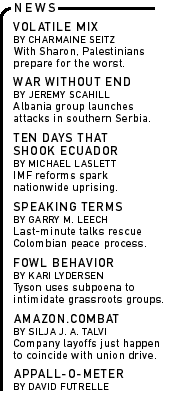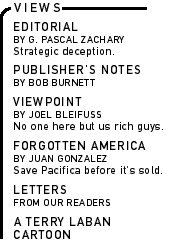

|

|

|

|
| |
|
|
|
A struggle between indigenous organizations protesting IMF austerity measures and the government paralyzed Ecuador for 10 days in early February. Last year, Ecuador suffered nearly 100 percent inflation which, combined with the dollarization of the economy, slashed Ecuadorians' savings and purchasing power. The government began a process of privatization, starting with the country's water supply. Meanwhile, indigenous communities watched the ongoing exploitation of their traditional lands for oil exploration and other types of resource extraction. In December, President Gustavo Noboa implemented IMF- recommended austerity measures to reduce inflation and debt. The government raised bus fares (the main form of transportation for most Ecuadorians) by 75 percent and increased the price of gasoline by 25 percent. In response, the three main indigenous organizations in Ecuador--Conaie, Fenocin and Feine--forged an alliance and mobilized tens of thousands of protesters. They demanded a repeal of the price increases, the implementation of a national currency, investment in social services, the dismantling of the agreement between Ecuador and the IMF, and autonomy for indigenous communities. They also blockaded highways throughout the country, causing shortages and skyrocketing prices. The blockades became a flashpoint between protesters and the military. As the uprising escalated, students, environmentalists, intellectuals and artists joined in. Quito residents brought food, medicine and clothing to the thousands camped at Catholic-run Salesiana University. On January 30, the government arrested the main leaders of the indigenous movement, charging them with subversion. But due to intense public pressure, they were released from prison two days later and negotiations were scheduled. A first attempt at negotiations failed when the government rejected the indigenous groups' request to meet directly with Noboa. The president then declared a state of emergency. Protesters began a hunger strike and confrontations with the police became more violent.
|

